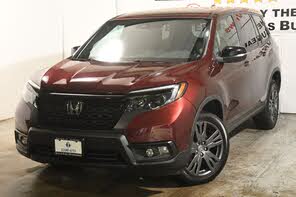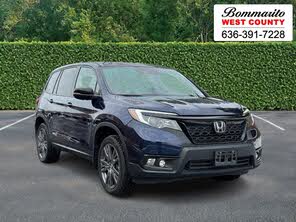2021 Honda CR-V vs 2021 Honda Passport
Overview | |
MSRP$32,790 | MSRP$25,350 |
Listings483 | Listings1266 |
Ratings & Reviews | |
User Reviews | User Reviews |
Expert reviews8.0 out of 10 | Expert reviews7.8 out of 10 |
Pros
Cons
| Pros
Cons
|
2021 Honda Passport Reviews SummaryThe 2021 Honda Passport was introduced for the 2019 model year. It carries over to 2021 largely unchanged, but with some additional features. First used by Honda in the early 1990s, the Passport name harkens back to a time when SUVs were more about rugged off-road capability. SUVs are very different beasts these days, and the Passport bridges the gap as an adventurous crossover SUV that is designed with daily life in mind. The Passport is closely related to the Honda Pilot. The fact that Honda offers multiple midsize SUVs might seem confusing. Automakers always talk about not wanting one model to cannibalize sales of another. Though the Honda Passport and the Honda Pilot are in the same category, the Passport stands out as a more active alternative. It leverages that older more rugged Honda nameplate and backs it up with some features not found on the family-hauling Pilot. | |
2021 Honda CR-V Reviews SummaryEven in a grim year, Honda is selling a staggering number of CR-Vs. The CR-V is the best-selling Honda by far. It’s also the second best-selling compact SUV, just behind the Toyota RAV4. And it's the fifth best-selling vehicle in the U.S., and if you take out all the commercial sales of full-size pickups it’s one of the two best-selling vehicles year in and year out. So it’s hard to argue against the CR-V formula. Honda’s been at this almost as long as crossovers have been a thing, launching the CR-V in 1997—a year after the RAV4 debuted. The funny thing is, aside from sales volume, there’s only one thing the CR-V particularly excels at. Aesthetics are subjective, but it would be hard to argue the CR-V is the best looking vehicle in its class. It’s not the cheapest. It’s not the best equipped, especially at the middle to lower trim levels. It’s not the fastest, nor is it the quietest, or the most fuel efficient. It’s not even the most reliable, showing up nowhere in J.D. Power's Most Reliable list. So what makes it so appealing to American consumers? Let’s see if we can figure that out. | |
No video found | No video found |
Popular Features & Specs | |
Engine3.5L 280 hp V6 | Engine1.5L 190 hp I4 |
Drive TrainFWD | Drive TrainFWD |
Seating Capacity5 | Seating Capacity5 |
Horsepower280 hp @ 6000 rpm | Horsepower190 hp @ 5600 rpm |
MPG City20 | MPG City28 |
MPG Highway25 | MPG Highway34 |
Engine | |
Engine Name3.5L 280 hp V6 | Engine Name1.5L 190 hp I4 |
Torque262 lb-ft @ 4700 rpm | Torque179 lb-ft @ 2000 rpm |
Horsepower280 hp @ 6000 rpm | Horsepower190 hp @ 5600 rpm |
DrivetrainFWD | DrivetrainFWD |
Fuel Economy | |
MPG City20 | MPG City28 |
MPG Highway25 | MPG Highway34 |
Interior | |
Seating Capacity5 | Seating Capacity5 |
Safety | |
Front Crash Overall4 | Front Crash Overall5 |
Side Crash Overall5 | Side Crash Overall5 |
Dimensions & Capacity | |
Cargo Space41.2 cu ft | Cargo Space39.2 cu ft |
Curb Weight3959 lbs | Curb Weight3337 lbs |
Height71.6 in | Height66.1 in |
Length190.5 in | Length182.1 in |
Width78.6 in | Width73.0 in |
Wheelbase111.0 in | Wheelbase104.8 in |
Maximum Payload1332 lbs | Maximum Payload1358 lbs |
Number of doors4 | Number of doors4 |
Maximum Towing Capacity3500 lbs | Maximum Towing Capacity1500 lbs |
Overview | ||
MSRP | $32,790 | $25,350 |
Listings | ||
Ratings & Reviews | ||
User reviews | ||
Expert reviews | 8.0 out of 10Read full review | 7.8 out of 10Read full review |
Pros & cons | Pros
Cons
| Pros
Cons
|
Summary | The 2021 Honda Passport was introduced for the 2019 model year. It carries over to 2021 largely unchanged, but with some additional features. First used by Honda in the early 1990s, the Passport name harkens back to a time when SUVs were more about rugged off-road capability. SUVs are very different beasts these days, and the Passport bridges the gap as an adventurous crossover SUV that is designed with daily life in mind. The Passport is closely related to the Honda Pilot. The fact that Honda offers multiple midsize SUVs might seem confusing. Automakers always talk about not wanting one model to cannibalize sales of another. Though the Honda Passport and the Honda Pilot are in the same category, the Passport stands out as a more active alternative. It leverages that older more rugged Honda nameplate and backs it up with some features not found on the family-hauling Pilot. | Even in a grim year, Honda is selling a staggering number of CR-Vs. The CR-V is the best-selling Honda by far. It’s also the second best-selling compact SUV, just behind the Toyota RAV4. And it's the fifth best-selling vehicle in the U.S., and if you take out all the commercial sales of full-size pickups it’s one of the two best-selling vehicles year in and year out. So it’s hard to argue against the CR-V formula. Honda’s been at this almost as long as crossovers have been a thing, launching the CR-V in 1997—a year after the RAV4 debuted. The funny thing is, aside from sales volume, there’s only one thing the CR-V particularly excels at. Aesthetics are subjective, but it would be hard to argue the CR-V is the best looking vehicle in its class. It’s not the cheapest. It’s not the best equipped, especially at the middle to lower trim levels. It’s not the fastest, nor is it the quietest, or the most fuel efficient. It’s not even the most reliable, showing up nowhere in J.D. Power's Most Reliable list. So what makes it so appealing to American consumers? Let’s see if we can figure that out. |
Video | No video found | No video found |
Popular Features & Specs | ||
Engine | 3.5L 280 hp V6 | 1.5L 190 hp I4 |
Drive Train | FWD | FWD |
Seating Capacity | 5 | 5 |
Horsepower | 280 hp @ 6000 rpm | 190 hp @ 5600 rpm |
MPG City | 20 | 28 |
MPG Highway | 25 | 34 |
Engine | ||
Engine Name | 3.5L 280 hp V6 | 1.5L 190 hp I4 |
Torque | 262 lb-ft @ 4700 rpm | 179 lb-ft @ 2000 rpm |
Horsepower | 280 hp @ 6000 rpm | 190 hp @ 5600 rpm |
Drivetrain | FWD | FWD |
Fuel Economy | ||
MPG City | 20 | 28 |
MPG Highway | 25 | 34 |
Interior | ||
Seating Capacity | 5 | 5 |
Safety | ||
Front Crash Overall | 4 | 5 |
Side Crash Overall | 5 | 5 |
Dimensions & Capacity | ||
Cargo Space | 41.2 cu ft | 39.2 cu ft |
Curb Weight | 3959 lbs | 3337 lbs |
Height | 71.6 in | 66.1 in |
Length | 190.5 in | 182.1 in |
Width | 78.6 in | 73.0 in |
Wheelbase | 111.0 in | 104.8 in |
Maximum Payload | 1332 lbs | 1358 lbs |
Number of doors | 4 | 4 |
Maximum Towing Capacity | 3500 lbs | 1500 lbs |
The 2021 Honda Passport was a distinctive SUV that generated a lot of appeal with its muscular aesthetics and spacious interior. Essentially a shortened version of the Honda Pilot, it featured two rows of seats instead of three, earning it the nickname "Pilot Sport" among enthusiasts. The interior dashboard layout of the Passport was virtually identical to the Pilot, inclusive of Honda’s controversial “button shifter” design, replacing the conventional gear lever with a series of push buttons. Despite this divisive feature, the cabin offered high-quality materials throughout, resulting in a sophisticated feel.
Trim levels in the Passport — Sport, EX-L, Touring, and Elite — catered to a range of buyers. The entry-level Sport included features such as 20-inch alloy wheels, LED fog lights, and push-button start. Climbing up the range to the EX-L brought in leather upholstery, a power moonroof, and a power rear liftgate. The Touring trim added front-and-rear parking sensors and a hands-free liftgate, while the top-tier Elite came with features like heated and ventilated front seats and a heated steering wheel.
On the other hand, the 2021 Honda CR-V adopted a more uniform, albeit somewhat nondescript design synonymous with compact crossovers. Its design included some distinguishing touches like a uniquely shaped grille and subtle chromed plastic features, yet it generally blended into the compact crossover crowd. The CR-V was available in eight colors, though the vibrancy was reserved for higher trims.
The cabin of the CR-V aimed for practicality and comfort, offering choices between black, gray, and ivory upholstery, dependent on the trim. Higher trims enhanced the interior with wood panels and additional chrome accents. While competitive models like the Kia Sportage and Hyundai Tucson provided distinctive styling even at mid-tier trims, the CR-V bet on its conservative design's broad appeal.
















Performance-wise, the 2021 Honda Passport boasted a robust 3.5-liter V6 engine across all trims, churning out 280 horsepower and 262 lb-ft of torque. This power was managed by a nine-speed automatic transmission. With standard front-wheel drive (FWD) and an optional all-wheel drive (AWD) system, the Passport offered capabilities suited for both daily commuting and occasional off-road ventures. The AWD model's Intelligent Traction Management System catered to varied terrains with Snow, Sand, and Mud drive modes. Additionally, the Passport sported a respectable ground clearance of 8.1 inches and an impressive towing capacity of up to 5,000 pounds with AWD.
The 2021 Honda CR-V, in contrast, came equipped with a turbocharged 1.5-liter four-cylinder engine producing 190 horsepower. Its power delivery, managed by a continuously variable transmission (CVT), was designed for smooth acceleration rather than exhilarating speed. While its 0-60 mph time of 7.8 seconds wasn’t particularly quick, it was competitive among other compact crossovers. Like the Passport, the CR-V offered FWD as standard, with AWD available at an added cost. The CR-V’s suspension setup—MacPherson strut front and multi-link rear—was typical for the class and provided reliable, predictable handling.
The Passport excelled in interior space and cargo capacity. With the rear seats folded, it offered a generous 100.8 cubic feet of cargo volume, while maintaining up to 50.5 cubic feet with the second row in use. Additional storage included an under-floor tray providing an extra 2.5 cubic feet. The Passport’s upright seating position not only ensured excellent visibility but also contributed to a comfortable drive experience. Both front and rear seats featured deep in-door pockets, enhancing utility.
The CR-V was designed to accommodate five passengers comfortably, alongside their cargo. It featured a notable 102.9 cubic feet of passenger volume, outperforming the Toyota RAV4. When it came to cargo space, the CR-V provided 75.8 cubic feet with the rear seats folded, comfortably accommodating a large amount of luggage. Tailgate functionality varied by trim, with the EX-L and Touring trims offering power and hands-free options respectively. However, roof rails for additional cargo stood exclusive to the top-tier Touring trim, limiting the practicality of lower trims for load-carrying beyond the interior.
In the technology department, the Passport made a leap with standard Android Auto and Apple CarPlay integration, accessible through an 8-inch touchscreen infotainment system standard across all trims. Despite these welcome additions, the infotainment system left something to be desired with its dated graphics and somewhat confusing menu layout. The controls, particularly the volume dial, were often critiqued for their lack of intuitive design.
The base CR-V LX’s technology was basic, featuring just a 5-inch color screen with Bluetooth connectivity. Higher trims from Special Edition onwards included a 7-inch high-definition touchscreen with Apple CarPlay and Android Auto. The audio experience ranged from a 180-watt six-speaker system in the Special Edition and EX to an upgraded 300-watt system with a subwoofer in the Touring trim. The CR-V also featured multiple charging ports across all but the base trim, with the Touring trim offering a wireless phone charger for added convenience.
The Passport was well-equipped with advanced safety features. Standard on all trims were automatic emergency braking, forward collision warning, lane departure warning, and adaptive cruise control. Additional safety features like blind-spot monitoring, rear cross-traffic alert, and parking sensors were available. The Passport achieved a five-star overall rating from the NHTSA and "Good" scores in most IIHS crash tests. However, its headlight performance and child-seat anchor ease of use were rated as "Acceptable."
The CR-V excelled in safety, earning both a five-star NHTSA rating and an IIHS Top Safety Pick award. Its Honda Sensing suite, standard across all trims, included forward collision warning, lane departure warning, automatic emergency braking, road departure mitigation, lane-keeping assist, and adaptive cruise control. A multi-angle rearview camera and auto high-beam headlamps were also standard. Blind-spot monitoring and rear cross-traffic alert were added from the EX trim upwards. Despite these strengths, the CR-V received "Acceptable" scores for headlight performance and the LATCH system's ease of use.
CarGurus highlights

According to CarGurus experts, the overall rating for the 2021 Honda Passport was 8.0 out of 10, while the 2021 Honda CR-V scored 7.8 out of 10. Both vehicles offer a blend of practicality, performance, and technology; however, the Passport edges out the CR-V with its stronger performance, extensive cargo capacity, and robust towing capabilities. Thus, for those seeking a well-rounded SUV with a perfect balance of utility and power, the 2021 Honda Passport is the recommended choice.
Choose the 2021 Honda CR-V if:
- You seek comprehensive safety features standard across all trims, particularly within a family-oriented SUV.
- You want a crossover with a higher cargo space relative to its compact form without compromising passenger comfort.
- You value the integration of modern infotainment features like Apple CarPlay and Android Auto in lower trims for convenience.
Choose the 2021 Honda Passport if:
- You need robust towing capabilities up to 5,000 pounds.
- You desire a spacious interior with high-quality materials and superior cargo capacity.
- You prefer an SUV with a powerful V6 engine and versatile all-wheel drive options.
CarGurus highlights

According to CarGurus experts, the overall rating for the 2021 Honda Passport was 8.0 out of 10, while the 2021 Honda CR-V scored 7.8 out of 10. Both vehicles offer a blend of practicality, performance, and technology; however, the Passport edges out the CR-V with its stronger performance, extensive cargo capacity, and robust towing capabilities. Thus, for those seeking a well-rounded SUV with a perfect balance of utility and power, the 2021 Honda Passport is the recommended choice.
Choose the 2021 Honda CR-V if:
Shop Now- You seek comprehensive safety features standard across all trims, particularly within a family-oriented SUV.
- You want a crossover with a higher cargo space relative to its compact form without compromising passenger comfort.
- You value the integration of modern infotainment features like Apple CarPlay and Android Auto in lower trims for convenience.
Choose the 2021 Honda Passport if:
Shop Now- You need robust towing capabilities up to 5,000 pounds.
- You desire a spacious interior with high-quality materials and superior cargo capacity.
- You prefer an SUV with a powerful V6 engine and versatile all-wheel drive options.

By: CarGurus + AI
At CarGurus, our team of experienced automotive writers remain at the heart of our content operation, conducting hands-on car tests and writing insightful guides that are backed by years of industry experience. To complement this, we are harnessing AI to make our content offering more diverse and more helpful to shoppers than ever. To achieve this, our AI systems are based exclusively on CarGurus content, ratings and data, so that what we produce is both unique to CarGurus, and uniquely helpful to car shoppers.








































